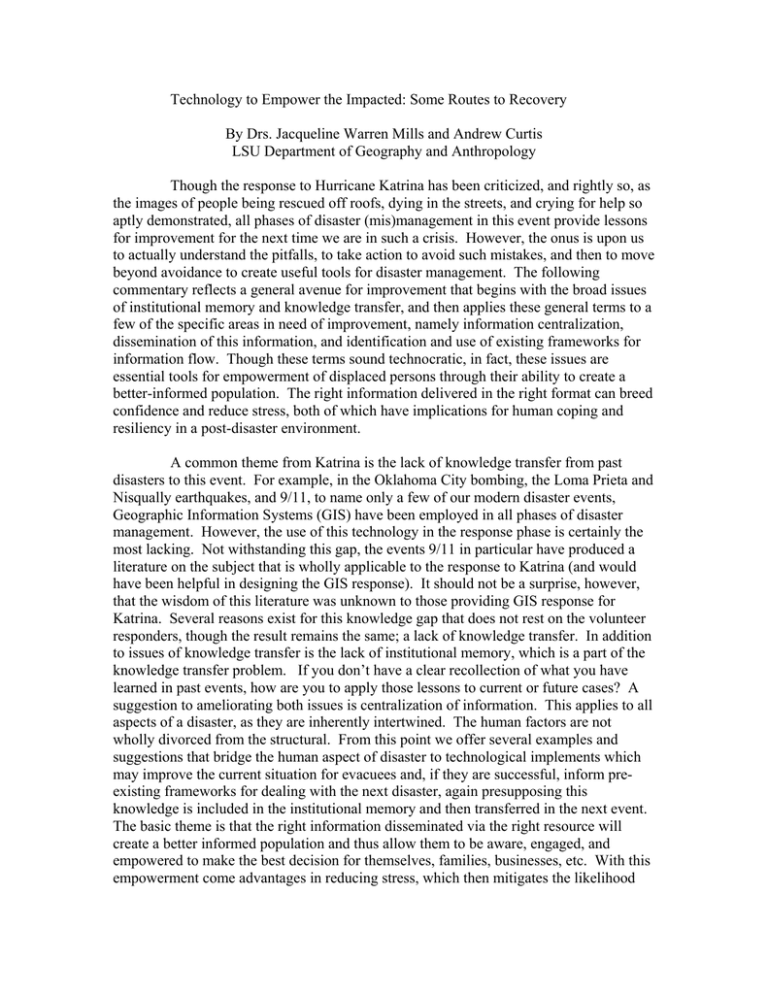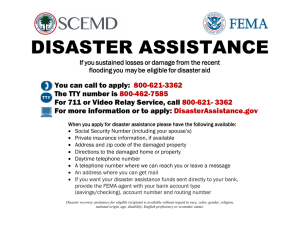Technology to Empower the Impacted: Some Routes to Recovery
advertisement

Technology to Empower the Impacted: Some Routes to Recovery By Drs. Jacqueline Warren Mills and Andrew Curtis LSU Department of Geography and Anthropology Though the response to Hurricane Katrina has been criticized, and rightly so, as the images of people being rescued off roofs, dying in the streets, and crying for help so aptly demonstrated, all phases of disaster (mis)management in this event provide lessons for improvement for the next time we are in such a crisis. However, the onus is upon us to actually understand the pitfalls, to take action to avoid such mistakes, and then to move beyond avoidance to create useful tools for disaster management. The following commentary reflects a general avenue for improvement that begins with the broad issues of institutional memory and knowledge transfer, and then applies these general terms to a few of the specific areas in need of improvement, namely information centralization, dissemination of this information, and identification and use of existing frameworks for information flow. Though these terms sound technocratic, in fact, these issues are essential tools for empowerment of displaced persons through their ability to create a better-informed population. The right information delivered in the right format can breed confidence and reduce stress, both of which have implications for human coping and resiliency in a post-disaster environment. A common theme from Katrina is the lack of knowledge transfer from past disasters to this event. For example, in the Oklahoma City bombing, the Loma Prieta and Nisqually earthquakes, and 9/11, to name only a few of our modern disaster events, Geographic Information Systems (GIS) have been employed in all phases of disaster management. However, the use of this technology in the response phase is certainly the most lacking. Not withstanding this gap, the events 9/11 in particular have produced a literature on the subject that is wholly applicable to the response to Katrina (and would have been helpful in designing the GIS response). It should not be a surprise, however, that the wisdom of this literature was unknown to those providing GIS response for Katrina. Several reasons exist for this knowledge gap that does not rest on the volunteer responders, though the result remains the same; a lack of knowledge transfer. In addition to issues of knowledge transfer is the lack of institutional memory, which is a part of the knowledge transfer problem. If you don’t have a clear recollection of what you have learned in past events, how are you to apply those lessons to current or future cases? A suggestion to ameliorating both issues is centralization of information. This applies to all aspects of a disaster, as they are inherently intertwined. The human factors are not wholly divorced from the structural. From this point we offer several examples and suggestions that bridge the human aspect of disaster to technological implements which may improve the current situation for evacuees and, if they are successful, inform preexisting frameworks for dealing with the next disaster, again presupposing this knowledge is included in the institutional memory and then transferred in the next event. The basic theme is that the right information disseminated via the right resource will create a better informed population and thus allow them to be aware, engaged, and empowered to make the best decision for themselves, families, businesses, etc. With this empowerment come advantages in reducing stress, which then mitigates the likelihood 2 for onset of stress-induced health and relationship maladies. Therefore, our points are as follows. 1) Technology can be used to empower the impacted. An important point to consider is culturally sensitive/neighborhood sensitive information flow. A criticism before the storm was that disaster planning was insensitive -- more neighborhood voices, and neighborhood responders should be included in the planning. The stress effects of a major disaster are exaggerated by the feeling of abandonment --obviously this happened in Katrina. In the Bioterrorism literature it is accepted that stress will come from uncertainty -- for example, if there is a disease outbreak, is the environment now clean? If we put all these together -- we have a population that was already highly prone to stress, which suffered terribly during the storm, and for many continue to suffer, who feel as though they were "left". It now must be a priority to maximize "information" flow back to these people to so that the stress of uncertainty is reduced. Part of this process is to collect the right data so we know what is happening in a timely manner. The other part is information dispersal; technologies such as Google Earth can help, though we must find other ways to relay this type of information to those who do not have access to the Internet or computers. 2) Framework for dissemination. Another aspect of creating a better informed population is providing assistance with the technology, as not everyone works on the same level of computer and web literacy, but this must be accomplished utilizing an existing framework – one more new group/resource to learn to navigate is not needed and would only create more stress and in the end, not be utilized and therefore a waste - public information of areas to be rebuilt and how to communicate – web-based with locations set up around diaspora to assist – dig video/gps with relevant shapefiles in viewer that overlays this information on post and pre-event imagery. 3) Technology and democratization of information. Part of this democratization of information through technologies is a centralized online resource for information well-advertised, well in advance; evacuation, especially if long-term, leads to a sense of not knowing and being overwhelmed by the barrage of information and resources to help them; one website could serve as source for contacting friends/families/employers; providing FEMA and Red Cross information; linking to a source such as Google Earth where displaced persons could access status reports on their community using post-event imagery, for example the GPS enabled Digital Video technology where shapefiles of themes such as flood depth and extent can be overlaid their area of interest, as well as data on power and water utilities being reinstated. 3 4) If you fail to plan, you’re planning to fail. Arrangements for various types of disaster management support are in place preevent with local stakeholders, for example, universities; on a regional basis for housing, damage assessment – not only important for structural issues, but for issues of human well-being, support payments, information on recovery process so residents can make more informed decisions, therefore feeling involved and therefore reducing alienation and associated stress of not knowing (frameworks of churches, shelters, libraries, schools, etc.). 5) Confidence and empowerment. Armed with the right information, people can then make decisions with confidence; demand mitigation strategies that are proven effective in order to build the confidence of private citizens and businesses that all that can be done has been done to protect life and property in case of disaster, for without confidence (and it may already be too late on this point) investment will not occur at the rates needed to bring NOLA back




